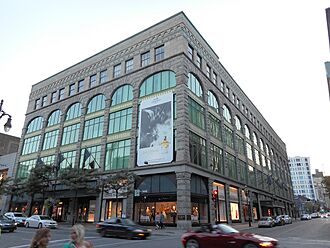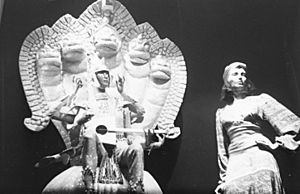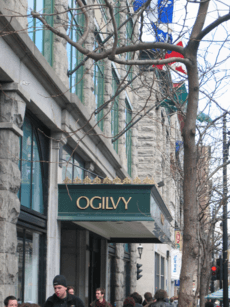Holt Renfrew Ogilvy facts for kids
Quick facts for kids Holt Renfrew Ogilvy |
|
|---|---|
 |
|

Exterior of Ogilvy (2014)
|
|
| Former names | Ogilvy (1866–2019) |
| General information | |
| Status | Open |
| Type | Department store |
| Architectural style | Romanesque Revival |
| Location | 1307 Saint Catherine Street West, Montreal, Quebec, Canada |
| Coordinates | 45°29′52.2″N 73°34′31.1″W / 45.497833°N 73.575306°W |
| Current tenants |
|
| Opened | 1912 |
| Renovated | 2017–2020 |
| Renovation cost | $150 million |
| Client | James Angus Ogilvy |
| Owner | Wittington Investments (Weston family) |
| Technical details | |
| Floor count | 6 |
| Floor area | 250,000 square feet (23,000 m2) of selling space |
| Design and construction | |
| Architect | David Ogilvy |
| Renovating team | |
| Renovating firm | Jeffrey Hutchison & Associates |
Holt Renfrew Ogilvy is a famous luxury department store in Montreal, Quebec, Canada. People often still call it Ogilvy. It's located on Saint Catherine Street West.
The store was designed by David Ogilvy for his father, James Angus Ogilvy. It first opened its doors in 1912. In 2011, a company called Wittington Investments bought the store. This company is owned by the Weston family.
From 2017 to 2020, the Ogilvy building was renovated and expanded. Another luxury store, Holt Renfrew, which was nearby, moved into the Ogilvy building. Now, it's known as Holt Renfrew Ogilvy. The store has a huge selling area of about 23,225 square meters. It's sometimes called the "grande dame of Saint Catherine Street" because it's one of the oldest and most respected stores there.
Ogilvy started as a "dry goods" store in 1866. Dry goods meant things like fabrics, clothing, and household linens. By 1920, it had become a full department store. Today, it has many smaller shops inside it, featuring different luxury brands.
Template:TOC limit=3
Contents
The Early Years: 1800s
How Ogilvy's Began
In 1866, a man named James Angus Ogilvy came to Montreal from Kirriemuir, Scotland. He opened a store that sold dry goods. It was located on Mountain Street. People say he started with just one counter and one employee.
For ten years, his business stayed in the same spot. Then, he moved his "fancy and staple dry goods" store to a new corner. In 1884, he moved again. By 1889, James A. Ogilvy & Sons had grown. They started selling house furnishings and fine linens. They also sold a special type of fire hose.
Moving to Saint Catherine Street
In 1896, James Ogilvy opened a new, bigger store. It was a three-story building made of granite. This new store was at the corner of St. Catherine Street West and Mountain Street. James's son, David Ogilvy, who was an architect, designed it.
The store was very modern for its time. It had many features to make shopping easy and comfortable. There was even a special sitting room for ladies. It had cherrywood furniture and writing tables. Even with the bigger store, Ogilvy said his business would stay focused on dry goods. He said, "Our business is dry goods." One of their old catalogs even called Ogilvy's the "largest exclusive dry goods store in Canada."
Growing in the 1900s
A Brand New Building
For 16 years, the store stayed at the same corner. But business was growing fast! So, Ogilvy bought land right across the street. Construction for a new building began in 1908.
The new store was four stories tall. It was designed in the Romanesque Revival style. It cost over a million dollars to build. The grand opening was in March 1912. News reports talked about how spacious the new store was. It could hold thousands of people at once. Advertisements called it "The Daylight Store." This was because it had so many windows that let in natural light.
Sadly, the founder, James A. Ogilvy, passed away the year before the new store opened. People remembered him as an honest and generous person. He gave a lot to his church and local charities.
Changes from 1920 to 1949
By 1920, Ogilvy's was no longer just a dry goods store. It had become a full department store. It offered new services like a "Hair Dressing Parlor" and a "Lunch Room." The store's ownership also changed.
In 1927, a young man named J. Aird Nesbitt convinced his father to buy Ogilvy's. J. Aird Nesbitt was only 19 at the time. He planned to sell the business quickly for a profit. But he "fell in love with the place" instead. He ended up managing Ogilvy's for the next 54 years!
J. Aird Nesbitt became a very important person in Montreal's retail world. He was known for being creative and trying new things. He didn't follow the usual ways of big department stores. He once said he was "more showman than storekeeper."
Soon after taking over, he added a fifth floor to the building. He opened "Tudor Hall," a music hall with 300 seats. It had a beautiful pipe organ. This hall hosted many events. There were public concerts, puppet shows, and even performing baby elephants! Early radio shows were broadcast from there. The first Montreal Symphony Orchestra broadcast across Canada happened there. Canada's first experimental television broadcast in 1931 was also from Tudor Hall. Other amazing things were displayed, like the world's fastest airplane in 1932. Nesbitt had it taken apart and rebuilt inside the store!
Nesbitt also focused on making the store's inside look elegant. Chandeliers became common. In the 1960s, he bought a huge crystal chandelier from an old theater. It had 100 lights and was over a century old. He put it on display on Ogilvy's ground floor, where it still hangs today.
Nesbitt believed in selling items that customers would truly enjoy. He said they wanted to bring in "delectable and exciting things." He didn't always worry if they would be a huge commercial success. He just wanted them to be a "pleasure to have in the store."
He also honored the store's Scottish roots, and his own. He introduced tartan shopping bags. He also started the tradition of a Scottish bagpiper. The bagpiper would parade through the store, playing music for shoppers and staff. This tradition started in 1945. At first, the bagpiper played only on Saturdays to close the store. Later, it became a daily event. For many years now, the bagpiper plays at noon, walking through all the floors.
Nesbitt was also behind the store's famous annual Christmas window display. In 1947, he asked a German toy company, Steiff, to create two animated holiday scenes. These were called "The Mill in the Forest" and "The Enchanted Village." They had dozens of handmade mechanical toy animals. These animals had over a hundred moving parts! In 2008, these displays were fully repaired.
Later Years: 1950 to 1999
In the 1960s, Ogilvy's was one of the first stores to use trendy words like "go-go" and "mod" in its ads. It also embraced the "Chelsea look" and sold miniskirts by British designer Mary Quant. Ogilvy's even opened smaller stores in other parts of Montreal. These were in Fairview Pointe Claire in 1965 and Anjou in 1968.
However, by the 1970s, the store was no longer seen as the top fashion spot. It became known for its more traditional customers. Its profits were also going down.
In 1981, after more than 50 years, J. Aird Nesbitt retired. Edward Walls became the new leader. He wanted to reduce the number of departments in the store. There were 66 different departments, selling everything from antiques to televisions.
Four years later, in 1985, the Nesbitt family sold Ogilvy's. It was bought by a Montreal development group called Equidev. The new owners started big renovations. Much of the store was completely redone. They introduced a new idea called "store within a store." This meant Ogilvy's became a collection of fancy shops and boutiques. These smaller shops were run by independent retailers and brands. But they all followed Ogilvy's overall rules.
In November 1986, the first renovated part, the second floor, was revealed. It took two more years to finish remodeling the rest of the store. After the renovations, 85 percent of the store's space was rented out to about 50 different retailers. In 1994, Standard Life Assurance Company bought Ogilvy.
Ogilvy in the 2000s
In 2000, the store was sold again to Pyxis Real Estate Equities Inc. In 2004, the store had another renovation that cost $12 million.
In 2010, a group from Quebec bought it. But within a year, it was sold again. This time, it was bought by the Selfridges Group Limited. This group is part of Wittington Investments Limited. Wittington also owns other fancy stores like Selfridges in the UK and Holt Renfrew in Canada.
In 2013, there were talks about turning the Ogilvy building into a new "Holt Renfrew Ogilvy" store. The plan was to close the existing Holt Renfrew store nearby and move it into the Ogilvy building. This big renovation happened from 2017 to 2020. It added about 3,700 square meters of space. This brought the total store size to about 23,000 square meters.
See also
- List of Canadian department stores







